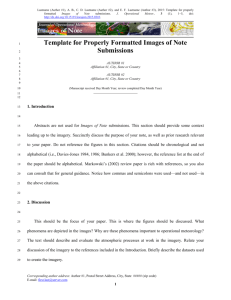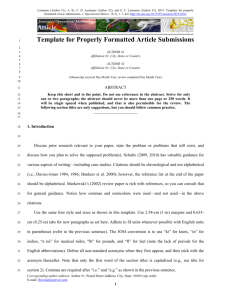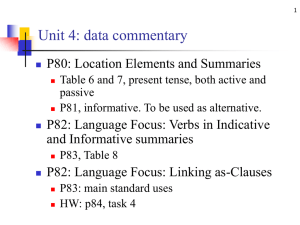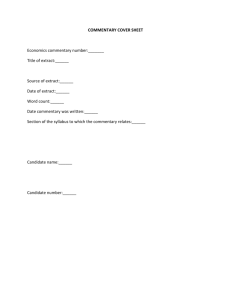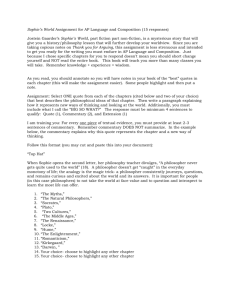Click here for Commentary template.
advertisement
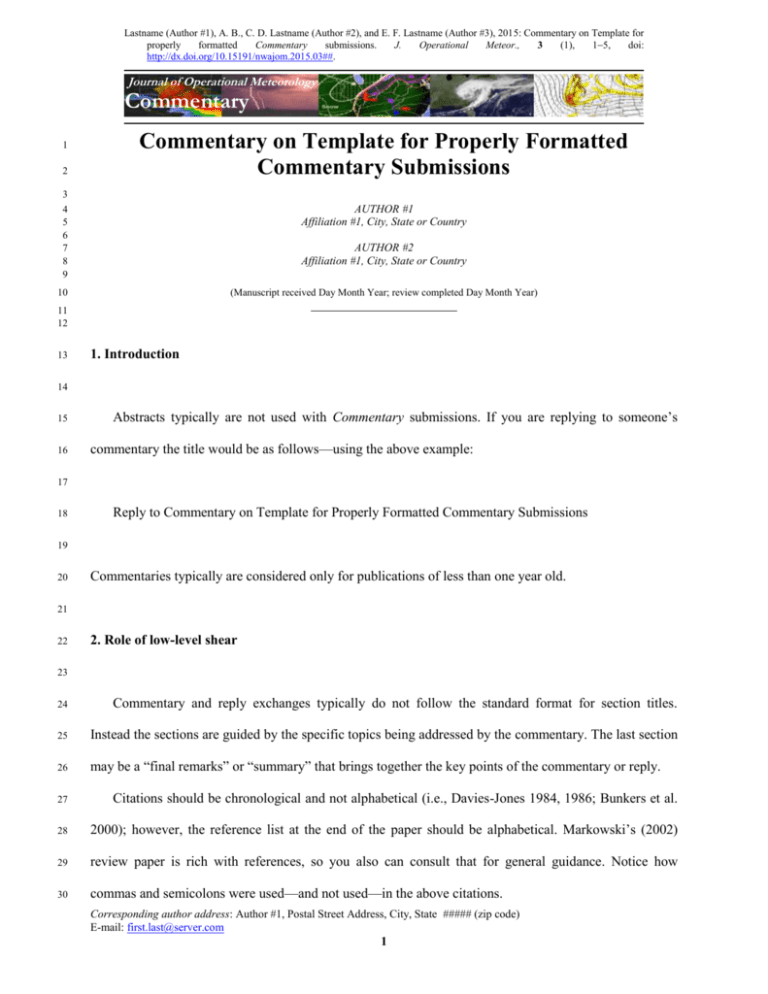
Lastname (Author #1), A. B., C. D. Lastname (Author #2), and E. F. Lastname (Author #3), 2015: Commentary on Template for properly formatted Commentary submissions. J. Operational Meteor., 3 (1), 15, doi: http://dx.doi.org/10.15191/nwajom.2015.03##. Journal of Operational Meteorology Commentary 1 2 Commentary on Template for Properly Formatted Commentary Submissions 3 4 5 6 7 8 9 AUTHOR #1 Affiliation #1, City, State or Country 10 (Manuscript received Day Month Year; review completed Day Month Year) AUTHOR #2 Affiliation #1, City, State or Country 11 12 13 1. Introduction 14 15 16 Abstracts typically are not used with Commentary submissions. If you are replying to someone’s commentary the title would be as follows—using the above example: 17 18 Reply to Commentary on Template for Properly Formatted Commentary Submissions 19 20 Commentaries typically are considered only for publications of less than one year old. 21 22 2. Role of low-level shear 23 24 Commentary and reply exchanges typically do not follow the standard format for section titles. 25 Instead the sections are guided by the specific topics being addressed by the commentary. The last section 26 may be a “final remarks” or “summary” that brings together the key points of the commentary or reply. 27 Citations should be chronological and not alphabetical (i.e., Davies-Jones 1984, 1986; Bunkers et al. 28 2000); however, the reference list at the end of the paper should be alphabetical. Markowski’s (2002) 29 review paper is rich with references, so you also can consult that for general guidance. Notice how 30 commas and semicolons were used—and not used—in the above citations. Corresponding author address: Author #1, Postal Street Address, City, State ##### (zip code) E-mail: first.last@server.com 1 AuthorA et al. NWA Journal of Operational Meteorology Day Month Year 31 32 3. Role of upper-level shear 33 34 Use the same font style and sizes as shown in this template. Use 2.54-cm (1-in) margins and 0.635- 35 cm (0.25-in) tabs for new paragraphs as set here. Adhere to SI units whenever possible with English units 36 in parentheses (refer to the previous sentence). The JOM convention is to use “kt” for knots, “in” for 37 inches, “n mi” for nautical miles, “lb” for pounds, and “ft” for feet (note the lack of periods for the 38 English abbreviations). Define all non-standard acronyms when they first appear, and then stick with the 39 acronym thereafter. Note that only the first word of the section titles is capitalized (e.g., see title for 40 section 2). Commas are required after “i.e.” and “e.g.” as shown in the previous sentence. Note that “n” 41 dashes are used for ranges of values and regular dashes are used for hyphenation, respectively (e.g., the 42 01-km shear was favorable tornadoes). 43 The total number of double-spaced pages cannot exceed five, including the title, body, 44 acknowledgments, and references. Figures and tables (e.g., Table 1) are excluded from this five-page 45 limit. If you exceed the five-page limit, you must contact and get approval from the Editor before 46 submitting your Commentary. If accepted for publication, your paper will be in a single-spaced, double- 47 column format, with the figures and tables embedded at appropriate places within the document. 48 49 4. Comparison with modeling studies 50 51 Cite figures chronologically. Always abbreviate figures (e.g., Fig. 1) unless they begin a sentence. 52 Figure 2 is an example of an appropriate figure. Moreover, figures should be placed at the end of the 53 paper for the review process. If you include an animation as part of the figure, please include a link to that 54 animation as shown in Fig. 2. State names are not abbreviated in the main body of the paper, but they are 55 abbreviated in table and figure captions (e.g., Fig. 2). ISSN 2325-6184, Vol. #, No. # 2 AuthorA et al. NWA Journal of Operational Meteorology Day Month Year 56 The review process and technical editing can be slowed considerably if (i) figures, tables, and 57 references are not cited properly throughout the manuscript or (ii) the reference list contains multiple 58 errors, is improperly formatted, or is incomplete. Depending upon the extent of improper citing and 59 formatting, the manuscript may be returned to the author before entering review and/or technical editing. 60 61 5. Final remarks 62 63 64 As briefly as possible, summarize what was presented in the previous sections. A bulleted list often works well here; please see Geerts (1999) for a discussion of this. 65 66 Acknowledgments. Remember to thank people who helped you. 67 68 REFERENCES 69 Bunkers, M. J., B. A. Klimowski, J. W. Zeitler, R. L. Thompson, and M. L. Weisman, 2000: Predicting supercell 70 71 72 73 74 75 76 77 78 motion using a new hodograph technique. Wea. Forecasting, 15, 61–79, CrossRef. Davies-Jones, R., 1984: Streamwise vorticity: The origin of updraft rotation in supercell storms. J. Atmos. Sci., 41, 2991–3006, CrossRef. ____, 1986: Tornado dynamics. Thunderstorm Morphology and Dynamics, E. Kessler, Ed., University of Oklahoma Press, 197–236. Geerts, B., 1999: Trends in atmospheric science journals: A reader’s perspective. Bull. Amer. Meteor. Soc., 80, 639651. Markowski, P. M., 2002: Hook echoes and rear-flank downdrafts: A review. Mon. Wea. Rev., 130, 852–876, CrossRef. 79 ISSN 2325-6184, Vol. #, No. # 3 AuthorA et al. NWA Journal of Operational Meteorology Day Month Year TABLES AND FIGURES 80 81 82 83 84 Table 1. Put the caption above the table. Use the following template for your tables. Ensure you have enough information in the caption to describe the table (e.g., dates, units, abbreviations). 85 Bulk0–8km SRW8km MLBRN MLLCL MLCAPE MLCIN SRH0–3km OUN, 5/30/2004 30.8 m s-1 22.6 m s-1 40 1272 m 2214 J kg-1 64 J kg-1 256 m2 s-2 BIS, 6/24/2002 21.5 m s-1 6.7 m s-1 18 1167 m 2483 J kg-1 9 J kg-1 341 m2 s-2 86 87 88 ISSN 2325-6184, Vol. #, No. # 4 TFX, 8/6/2002 43.1 m s-1 24.8 m s-1 7 1258 m 719 J kg-1 127 J kg-1 274 m2 s-2 AuthorA et al. NWA Journal of Operational Meteorology Day Month Year 89 90 91 92 93 94 95 Figure 1. Put figure captions below each figure. Figure captions can be single-spaced. Figures should be clearly legible with the font sufficiently large so you can read it. Include distance scales and north arrows when needed, such as in this case. Keep figures on separate pages for ease of review. Similar figures can have the same number but different letters (e.g., Figs. 1a, 1b, and 1c). Click image for an external version; this applies to all figures hereafter. ISSN 2325-6184, Vol. #, No. # 5 AuthorA et al. NWA Journal of Operational Meteorology Day Month Year 96 97 98 99 100 101 102 Figure 2. Radar reflectivity at 0012 UTC 30 October 2000 for the lowest four elevation angles (as annotated) from Molokai, HI (PHMO). The heights AGL of the storm centroid at each progressive angle are 687, 1751, 2738, and 3662 m (2254, 5744, 8982, and 12011 ft, respectively). A small yellow fiducial mark is indicated on each frame to illustrate midlevel overhang. The distance across an individual frame is 102 km (55 n mi). Click image for animation. 103 ISSN 2325-6184, Vol. #, No. # 6
